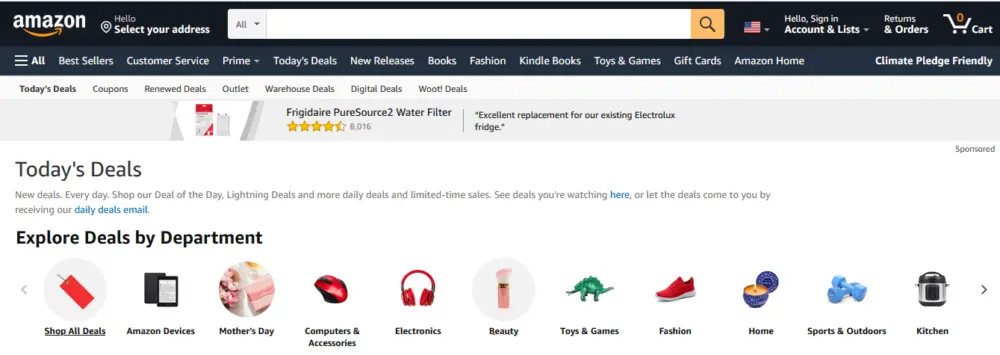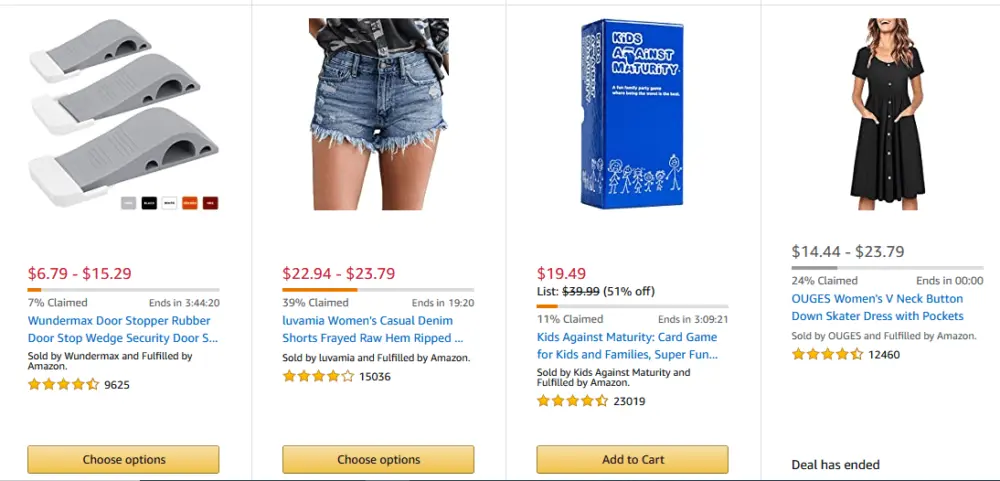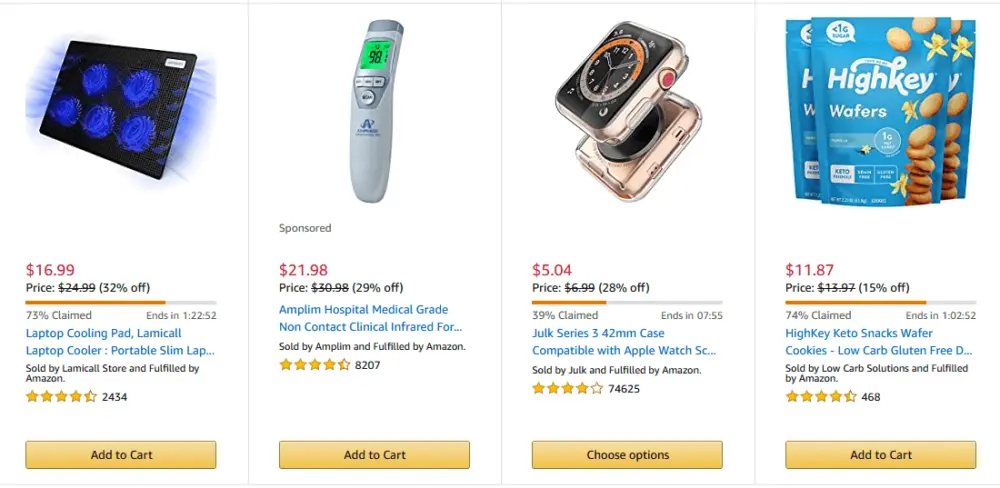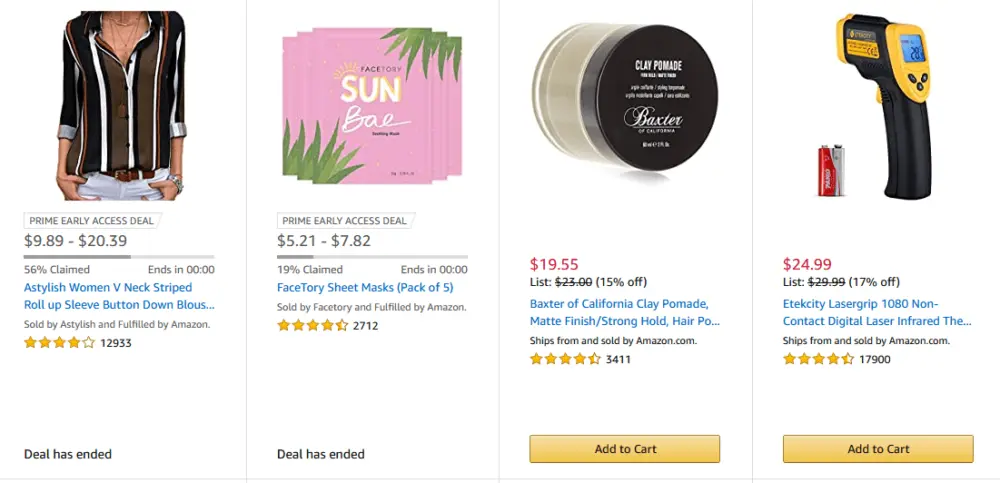
If you’ve been selling on Amazon for some time, there are high chances you’ve heard about Lightning Deals on Amazon. These deals can be a perfect way to increase your ranking on Amazon and improve your business if you are willing to temporarily sacrifice some margin.
Like all promotions, Amazon Lightning Deals have their own advantages and disadvantages. If you’ve not leveraged Lighting Deals before as an Amazon seller, you may be wondering what’s in for the seller.
In this blog post, we’ll cover the subject of Amazon Lightning Deals in detail. We’ll look at the pros and cons of these deals, how they work, how to create them, and much more to help you decide if they are worth it.
What are Amazon Lightning Deals?
Amazon Lightning Deals are time-bound, limited-stock promotional offers available on Amazon. Amazon offers these deals for a short period of time, usually 4 to 12 hours to entice customers to buy items.
Amazon limits Lightning Deals to one per customer at a time, and they end when the product completely sells out, or the offer period expires, whichever comes first.
Amazon Lightning Deals appear under the “Today’s Deals” section on the Amazon website. You can also find these deals across the Amazon website during Prime Day, Black Friday, and festive seasons.

Amazon runs thousands of Lightning Deals every day in various categories, including fashion, beauty, tech, home, and many more.
When a Lightning Deal launches, it appears with a status bar indicating the number of items that have been claimed and a timer showing how long the buyer has to check out or lose the deal. The Lightning Deal will also feature the product’s actual price, the discounted amount, and the final price. Since these deals are extremely time-sensitive, the buyer may have to check out as soon as possible, otherwise, they’ll lose the deal when the promotion period runs out, or the items on offer are 100% claimed.
To qualify for Lightning Deals, Amazon will require that you offer an appealing discount, normally 15% or more. You’ll also pay Lightning Deal fees to be able to hold these promotional offers. There are many other eligibility requirements that you’ll have to meet to qualify to run these deals on Amazon. We’ll look at these requirements in another section.
Whether you’re a new seller looking to improve your business, or a seasoned seller seeking to strengthen your brand, you can benefit from Lightning Deals on Amazon. Apart from making more sales, these deals help to drive more traffic to your product page, hence improving your ranking in the long run.
How do Amazon Lightning Deals work?
These deals are available to both sellers and vendors. You can access them from within your Advertising Tab on Seller Central or Vendor Central. As we’ve already mentioned, these deals are available for a limited time and run until the promotional period expires or until the product on offer completely sells out.
When you run a Lightning Deal on Amazon, shoppers will see the item featured in the deal and a label that affirms that the item is a Lightning Deal. It will also feature the item’s actual price and the final price to show customers the amount they can save. Below the price, there will be a status bar indicating the percentage of products that have been claimed. Also, you’ll see a timer indicating how much time is left on the deal.

The image above shows some example Lightning Deals, where you can see the deal details as mentioned earlier.
Lightning Deals are limited to one per customer. In other words, a customer can only purchase one of each of the Lightning Deal items.
A customer has 15 minutes to check out once they add a Lightning Deal item to their cart. When they add the item to their cart, there will be a timer indicating the time left to process the transaction. If they don’t check out within 15 minutes, they will miss out on the deal.
Amazon has designed these deals in a way that they are enticing to buyers. The one per customer rule, the time limit, and the limited quantity make Lightning Deals worthwhile for buyers. Price-savvy customers looking for exciting discounts on items feel compelled to check out on the spot so that they don’t lose out on these deals.
All you need to run Lightning Deals on Amazon is to meet eligibility requirements, pay the fees, and offer a reasonable discount that will entice Amazon shoppers to buy your items.
How much do Lightning Deals cost?
If you decide to run Lightning Deals on Amazon, you’ll be required to pay a fee. The fee is typically $150, though it may vary depending on the marketplace, seasonality, overall demand, and the timing when your deal runs. The fee amount can be higher when the overall demand is higher or time frames when there’s greater customer traffic. Also, you can expect the fee amount to be even higher during events such as Prime Day and Black Friday. The fee is automatically deducted from the seller’s account after the deal runs.
NOTE: The fee amount you’ll pay to run a Lightning Deal is not affected by the price, quantity, performance of the deal or variations included in the deal.
You’ll see the fee amount to pay for a Lightning Deal next to the Submit button when you submit your item.
When calculating the cost of a Lightning Deal, you’ll need to account for the promotional discount amount. Amazon requires that you give at least a 15% discount, but it’s best to offer a 20-35% to entice more buyers.

Despite the fee that you have to pay to run a Lightning Deal, the cost is worth it in the long run. When you run a Lighting Deal on Amazon, you can expect a major boost in your sales up to four times your regular daily sales. If you’re new on Amazon or you’ve recently added new products to your catalog, and they haven’t hit their stride yet, it’s a good idea to leverage Lightning Deals.
Eligibility requirements to run Amazon Lightning Deals
These are the conditions that you must meet as a seller to be eligible to create a Lightning Deal:
- You must be a Professional Seller: That means sellers with an individual account are not eligible to create Amazon lightning deals. The Professional Seller account costs $39.99 per month.
- Have 5 seller feedback ratings: This is a minimum average per month.
- Hold an overall 3.5 star rating: You must have a sales history with a rating of at least 3.5 stars to be allowed to create a Lighting Deal. If your rating is below 3.5 stars, you’ll have to focus on improving your Amazon feedback rating by providing a great consumer experience.
The products you want to feature in Amazon’s Lightning Deals must also be eligible. Specifically, your products must meet these criteria:
- Your products must each hold a rating of at least 3.0 stars. NOTE: The product reviews must be compliant with Amazon’s customer product reviews policies.
- The product must cover all its variations, where applicable.
- All products must be in new condition. That means you cannot run ‘USED’ items on Lightning Deals.
- Your products should not be restricted, offensive, or inappropriate.
- The product must be Prime-eligible in all regions.
- Your product must comply with pricing policies as well as deal frequency policies.
Amazon is strict when it comes to compliance with its policies, so it’s important to follow these guidelines to avoid penalties and account restrictions.
What are the advantages of running Lightning Deals on Amazon?
Sellers running Lighting Deals on Amazon can expect to benefit from the following:
Increase in sales
Like any other promotions, Lightning Deals are appealing to most shoppers, especially the price-savvy ones who are looking for the best deals. Although Amazon doesn’t make any promises regarding a boost in sales, you can expect a boost in sales anywhere from 2 to 4 times your regular daily sales. Even after the Lightning Deal is over, you can expect to see a continuation of the lift in sales.
If you’re struggling to make sales on Amazon and you can afford to give discounts of up to 25% on your products, it can be a good idea to give these deals a try.
Clears overstocked or stagnant inventory
Perhaps you’re looking to avoid long-term storage fees or have excess or stagnant inventory that you want to get off your hands. Through Amazon’s Lightning Deals, you can dispose a lot of inventory at once. By getting rid of excess or stagnant inventory, you’ll be able to save on long-term storage fees or make space for products that will sell better.
Drives traffic to your product page
A majority of Amazon shoppers visit the deals page to see if there are deals they can grab. In fact, the deals page is the most frequented page on the Amazon marketplace. Therefore, running Lightning Deals will result in an influx of customers visiting your product page even after the deal is over. The increased flow of traffic translates to improved organic ranking for your product listings thanks to clicks, reviews, and sales.
If you’re struggling to get your products in front of buyers, Lightning Deals can be a good way to increase the flow of traffic and strengthen your brand.
Lightning Deals are a great way to promote new products
If you’re selling new products and they haven’t hit their stride yet, Lightning Deals can be a perfect way to get your new products in front of many buyers.
Generally, the advantages of Lightning Deals go beyond making more sales on the day of running the deal. With more buyers coming in, you can improve your organic ranking and achieve higher conversions after the deals have lapsed.
The potential downsides of Amazon Lightning Deals
Cost
The main downside of Lightning Deals is the cost. Amazon requires you to pay a fee starting from $150. The cost of running Lightning Deals can also significantly lower your profit margins.
Amazon requires you to offer at least a 15% discount on your normal price to qualify. Taking into account the cost of running the deal and the value of your products, sometimes it may not be worth the amount you’d make from a boost in sales. But remember, you can still receive benefits down the road.
Lack of control over the exact time and date to run Lightning Deals
Although sellers can propose the specific week they would like to run their Lightning Deal, it is Amazon that determines the exact date and time for running the deals. They may choose to run them when customer traffic is low; hence a seller may not gain maximum exposure. It would be more ideal if sellers were allowed to choose the exact time and date for running their Lightning Deals, but, as yet, this isn’t a reality.
Peaks of orders can create fulfillment challenges
With Lightning Deals, you can expect a sharp increase in orders. Fulfilling these orders in a timely manner can be a challenge especially if you fulfill orders on your own. This can hurt your rating and reputation. If you can’t handle a possible spike in sales, running Lightning Deals may provides a risk to your brand and Amazon store’s reputation.
How to create Amazon Lightning Deals
Follow these steps to create your own Amazon Lightning Deals:
Step 1: Check if you’re eligible to run Lightning Deals
To qualify to run these deals, you must have a professional seller account, have an Amazon sales history with at least five seller feedback ratings per month and hold an overall rating of at least 3.5.
Step 2: Go to the deals menu in your Amazon Seller Central
Once there, navigate to Promotions, then go to Deals and click on Create a new deal. Next, choose your product and enter the relevant information for the deal.
Step 3: Schedule your Amazon Lightning Deal
Select a date range for the Lightning Deal. Remember that you can only select a specific week which you would like to run your deal, but you cannot choose the exact date and time. It’s Amazon that will pick the exact date and time to run the deal.
Step 4: Enter the deal price and number of units available for the deal
Enter your discounted price as well as the number of units available for the deal. Be sure to include your product’s variations, if applicable.
Step 5: Review your information and submit
Check the information you’ve entered to ensure it’s correct, and then submit your Lightning Deal for approval. Amazon will approve your Lightning Deal if you quality and schedule the date and time when your deal will run.

So are Amazon Lightning Deals worth it?
Lighting Deals can help some sellers increase their sales and organic ranking on Amazon. However, this will depend on the value of the products you’re selling and your pricing.
For some brands, running Lightning Deals can be a costly affair; hence not viable. Before you consider running these deals, it’s a good idea to do some math while taking into account all the costs involved in running them. This will help you determine if running a Lightning Deal is profitable or not.

